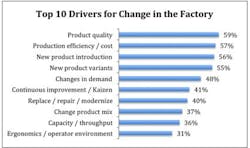Change is a given in manufacturing. Whether you’re meeting customer demands, fulfilling regulatory requirements, seeking ways to improve the bottom line or adapting to new technology, there will always be some aspect of change ongoing within your operations. So the question is not whether you can deal with change—if you couldn’t you wouldn't still be in business—but are you dealing with it effectively?
To examine the challenges facing manufacturers today and what the best practices are in dealing with it, Tech-Clarity (an independent research firm), conducted a survey of more than 250 manufacturers to understand how they approach change in the factory. Survey responses revealed that manufacturers make minor changes every month or two, moderate changes a few times a year, and major changes once or twice a year.
Responses to the survey were used to determine the top 10 drivers of change in today’s factories (see graphic accompanying this article at top). What’s most interesting about this list of changes is that it’s not just a couple of issues ranking highly with all the others coming in a distant second or third. According to Tech-Clarity, “On average, respondents chose more than six drivers for change per company… [which] leads to the conclusion that each company faces a large variety of reasons to make changes.”
The top two drivers for change—improving product quality and production efficiency/cost—are not surprising in their ranking because they directly impact bottom line savings. As Tech-Clarity put it: These are the reasons manufacturers most often “have to change.”
Following these bottom line driven issues are strategic, market-driven issues related to new products and changes in market demand. These factors point out why improving change management performance makes manufacturers more competitive, according to Tech-Clarity.
As for the challenges related to implementing these changes, the biggest challenges relate to the difficulty of predicting the results of the change. From encountering problems in determining the true cost of change to being confident in their understanding of the impact of that change, uncertainty about change clearly rules the day for most manufacturers. As Tech-Clarity stated it in their analysis of the findings: “How can companies make good cost-benefit or return on investment decisions related to change in the factory if they can’t accurately determine the cost and other impacts of the change?”
Where the rubber really hits the road is in the business impacts from change. According to Tech-Clarity, these impacts tend to fall into two categories: project impacts and outcome-related impacts.
Tech Clarity’s analysis says: “These impacts often occur when things don’t go as expected, which is frequently according to the issues reported. Perhaps not surprisingly (because of the challenge of predicting costs), cost overruns are relatively common (43 percent). Projects are also late and take too many resources. Well over one-third of companies (42 percent) report unplanned hours or overtime during the project as a significant negative impact and 42 percent miss project due dates. Experience shows that companies are used to these problems and budget for them, but then still frequently miss their contingency budgets and schedules.”
The real problem is these impacts reach beyond missed deadlines and budgets and tend to impact factors such as quality, efficiency and new product introduction.
Tech-Clarity notes “these risks and their consequences are directly in opposition to the business drivers for change, creating a strong need to address the issues that make change in the factory hard to plan and execute.”
Access the full report to read Tech-Clarity's take on what makes a company a top performer in response to change and the strategies they employed to deal with change-related challenges.
About the Author
David Greenfield, editor in chief
Editor in Chief

Leaders relevant to this article:
